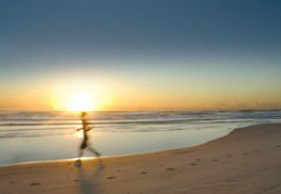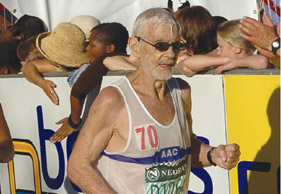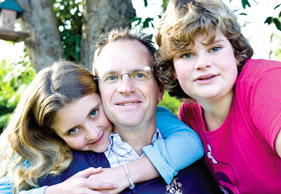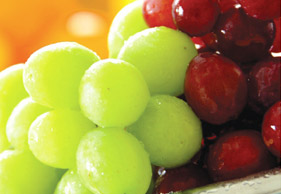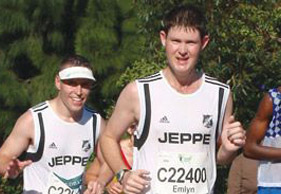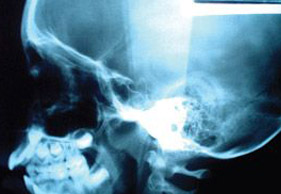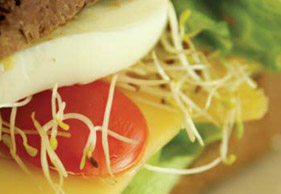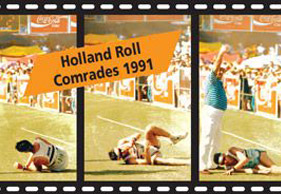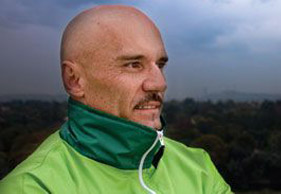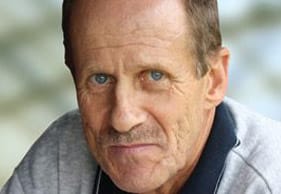Coma2Comrades is the incredible story of an athlete who, in the prime of his life, went out for a routine morning training run on St Patrick’s Day, 17 March 2006. His life would never be the same again. From that day onwards, it would be thrown into turmoil and turned completely upside down.
This is the Wayne Korras Story.
Wayne was born in Kensington in 1963, the second of four boys. He attended Dale College and was always a keen, all-round sportsman, playing first-team hockey, cricket and tennis.
Wayne the Doctor
From a young age, Wayne felt he had a calling to become a medical professional. He remembers living in Witbank as an eight-year-old. He was sick one night and his mother tended to him, asking him to wake her if he needed cough mixture during the night. His interest in medicine and in the diagnosis of sick people was awakened and from that night on, Wayne knew he would make medicine his life.
It was not a simple road to medical school but Wayne’s determination to succeed ensured that he would achieve his goal. It is this character trait, in fact, that shaped all the aspects of Wayne’s life. He remembers taking an aptitude test at school. The question: Name three things you want to do when you leave school. Wayne wrote: Number one, medical doctor; number two, medical doctor; and number three, medical doctor. His guidance teacher, Mr Reynolds, called him in and explained to him that he did not have the potential to be a doctor, as he was only top of the C class. He recommended instead that Wayne consider becoming a toolmaker, a maize miller or, if he was persistent in considering a professional field, a lawyer. Wayne researched these options, taking a day to observe individuals in each of these roles, but this only fuelled his determination to pursue medicine.
After matric, Wayne applied to the medical schools at UCT and Wits and was declined by both. Wayne, not one to give up, decided to do a BSc at Wits and to apply for the medical programme every year. He was declined time and time again, but for Wayne, doing anything other than practising medicine was not an option. At the end of his fourth and qualifying year, Wayne again applied, this time broadening his options and submitting applications to five universities. It was not to be. He was rejected from all five. He decided to pursue a BSc honours before applying again, but before he began his studies, his luck suddenly changed. The day before university was due to start, he got a call informing him that someone had withdrawn from medicine at Wits and he was first on the waiting list. Naturally, he jumped at the opportunity and was the first student at class the next day. He was so early, he actually had to wait for them to open the doors.
At the end of Wayne’s fourth year of medical school, he happened to meet his old guidance counsellor again. Wayne approached him and asked if he remembered the advice he had given him. He reminded him of the incident and gently suggested that, as a school psychologist, he should never doubt the ability of his students. He should instead point out that their chosen goals while difficult to achieve, could be reached with hard work and perseverance. The student had clearly become the teacher.
Wayne would go on to have a long career as a student. He spent four years completing his BSc, six years at medical school and another year doing what is referred to as ‘house jobs’, playing assistant to specialists. Once qualified, he had no idea what to specialise in, so he went to work at Johannesburg Hospital for six months in the plastic surgery field. This gave him the clarity he was looking for. He decided to become a General Practitioner. He preferred having patients with a variety of ailments, as opposed to being a specialist working in one area only.
Doctor Korras would spend 12 years working in a practice in Melville, before moving to Dunvegan, 18 months before his accident. Over this time he built up a reputation as an excellent GP and had a large and loyal customer base, people who trusted him with their lives.
Wayne the Athlete
Korras has always been an extremely talented and competitive athlete. He joined Bedfordview Country Club, the club he now runs for, to play hockey and cricket. He excelled in both disciplines. On the cricket front, he played in the premiership side, which included several famous Transvaal Mean Machine players of the era, such as Clive Rice, Rupert Hanley, Henry Fotheringham, Gordon McMillan and Drummond Dunlop. Korras played provincial hockey for Southern Transvaal in the late 80s. He was a centre forward who humbly says, “I tried to score regular goals.”
It was during one of the hockey seasons that Wayne felt the pull towards road running. The hockey team used to run the Bliss 21km as part of their training. Wayne ran the race with Gordon McMillan, who he constantly encouraged to speed up. Finding he was comfortable on the road, Wayne joined the running section in 1983/84.
It was during his second year of medicine that one of the girls in Wayne’s class bet him and his friend, Brett, that they would not finish Comrades the following year. The prize at stake? A dinner date with her. As it so often does, male testosterone took over. Wayne never got the dinner date, but he did fall in love with Comrades and what was to become a lifelong relationship with the race began that day.
In 1987, at the age of 23, Wayne completed his first Comrades in 10:41. On that day, he ran with Owen Anderson and Rupert Scott, fondly called the ‘mobile meatball’ because of his large frame. He clearly remembers the gooseflesh as he finished. Today, he has run a total of 16 Comrades, but says the feeling of exhilaration he felt finishing the first Comrades has never returned.
In his first few Comrades runs, Wayne was unable to break the 10:40 mark. He relied heavily on his general fitness from other sports and did very little mileage in preparation for the race. In fact, in his second year he only did 140km training and nearly bailed only 8km into the run. It was at this point that he noticed he was behind a girl with a ‘nice bum’. Mesmerised by this, he managed to get halfway and struggle his way to the end.
During the 1992 up run, Wayne caught up to one of the experienced runners from his club, Neil Alexandra, going up Field’s Hill. Neil wanted to know how much training he had done, and after finding out it was only 600km, Neil casually stated that Wayne was welcome to run alongside him for as long as he could. At the 60km mark, they were still together and Neil became the first person to point out to Wayne that if he actually put some effort into his training, he could be a much better runner. At Polly Shorts, Neil asked Wayne to run ahead, as he was struggling to keep up. Wayne went on to improve his time by over 1:10.
From this point, Wayne started training properly for Comrades and his times improved dramatically.
In 1998, Wayne ran his first silver in a time of 7:12. He contributes this mainly to his focused preparation and setting himself the goal of running his first silver in his Green Number year. He would go on to run six consecutive silvers with a best place finish of 162nd in 2002 and a best time of 6:50 in 2003, a massive improvement from the 10:52 and 9 869th place in 1989. What better example of his character and determination to succeed?
Wayne compares a fast Comrades with a round of golf. You can have a great score in a golf game if the bounce of the ball favours you in 50/50 situations. The beauty of Comrades is that you can’t just go out and have a fast run. You have to be alert the whole day and manage every aspect of the route. Most importantly, you need to prepare properly. There are no short cuts or lucky bounces.
Although Wayne’s passion is Comrades, he also has other impressive achievements, such as his Two Oceans silver, which he received for running the race in 3:58. When asked which silver is harder, Comrades or Two Oceans, he explains that, “Two Oceans is harder in terms of pace, but you only have two tough sections to negotiate. The difficult part of Comrades is that, although it is a slightly easier pace, it is literally double the distance over constantly challenging terrain.” Korras saved his PB marathon for a special occasion, the cobblestone roads of Paris where he ran a time of 2:46.
Hockey and Wits didn’t only bring together Wayne and road running. They also brought together Wayne and his wife, Robyn. They married in 1991 and have two beautiful daughters, Cailyn, 13, and Kesley, 11.
St Patrick’s Day 2006
Dr Wayne Korras woke early for his training run on the morning of 17 March 2006. He left the house a role model in a perfect world. He was a happy family man with a beautiful wife and two kids, a very successful General Practitioner and an extremely talented athlete. Little did he know that he would not return home that day.
The Bedfordview runners met at their regular rendezvous point in the Virgin Active car park. The club had just started increasing its morning run distance, so although they still ran the same route, the faster runners ran ahead in the A group and the B group followed. Because the Om Die Dam race was the following day, the A group was a small one consisting of only eight runners. Two of the runners with the group that morning were new. Richard Albrecht, who normally ran in the afternoons, had changed to mornings that week and Joe Mendoza, who had not run with the group for the last six months, had recently rejoined the group.
About 3km into the run, the A school stopped at a BP garage for water, then left to continue on the route. They were about 1km from the garage and running on Herman Road alongside the airport highway. Wayne was running with the group when he noticed a car coming towards them. JP Lombard, the driver of the vehicle, was on his way home from a friend’s house at 5:30am and claims to have fallen asleep at the wheel when he smashed into the running group. Wayne doesn’t remember much more about that morning, but fellow runners, Michelle Kellock and Grant Greeff, remember the incident vividly.
Michelle was running in front of the group alongside Grant. Wayne and Richard were just behind them. She recalls shouts from the group appealing to the driver to slow down as the vehicle veered towards them. The car just kept coming. Road traffic engineers have since established that the car was travelling at approx 88km/h. Grant allegedly pushed Michelle out the way just before he jumped to the side and the car missed them. Richard and Wayne took the full brunt of the vehicle’s force as it ploughed into the group. Richard was dragged on the bonnet for roughly 40 metres and Wayne was flung straight up, landing on the pavement. Joe was run over and caught between the pavement and the front wheel. Karl Quinn took a side impact which snapped his legs. Michelle recalls seconds of absolute chaos, the sounds of the screeching car and screaming voices and then just silence. Grant ran to the aid of Richard and Michelle, and then to Wayne. Wayne was lying on his stomach, unconscious. He had severe head injuries and was heaving as he breathed. Michelle stayed with him, talking to him as they waited for paramedics. She even removed her shirt to try and stop the bleeding. There was nothing Grant could do for Richard, so he waved down a taxi and called 911. He then went to the aid of Joe and they started CPR but it was too late. Both Richard and Joe died at the scene of the accident from massive internal injuries. Wayne refers to the incident as a design from above; he believes the Lord needed two more angels.
A medical specialist, Garth Diers, was amongst the approaching B group. He attended to Wayne on the scene as they waited for the paramedics to arrive. Once they arrived, Wayne was put onto a drip and a helicopter was called. Carl was transported by ambulance and Wayne was flown to Milpark Hospital. Several people on the scene doubted he would survive the trip to the hospital and a comment was passed, “This may be the last time you see your friend.” Deep in his heart, Wayne believes he heard this comment and it was a catalyst to his determined nature. He had spent his life proving he could do what other people told him wasn’t possible. He became a doctor despite the words of his old teacher. He ran a sub-seven hour Comrades despite a colleague’s claims that he couldn’t. This time, his biggest challenge would be to live when all those around him thought he would die.
As soon as his wife heard the news, she rushed to the hospital. Wayne had arrived at the hospital in a coma with severe head injuries, a broken right arm, leg and collar bone, three broken ribs on each side, three fractured vertebra and a fractured jaw and nose. Ironically, he was treated by Professor Boffard, who had been his lecturer at Wits. Robyn was referred to a head injury website to educate her on what the possible outcomes of the accident would be if Wayne did survive the coma. The risk of 14 day mortality with the severity of Wayne’s injuries was 81% and if Wayne survived, there was a risk of severe disability or worse.
Miraculously, on his wedding anniversary, 13 April, 28 days after the accident, Wayne Korras woke from his coma. He doesn’t remember much about the months that followed, but he had to spend four and a half months in hospital, two months in ICU and two and a half years in Netcare Rehab. At the age of 42, Wayne Korras had to re-learn the things we take for granted. He had to be re-taught to use the toilet, to walk and talk, to brush his hair and teeth, and to shave and get dressed. To make things more challenging, he did not react well to one of his medications and the side effects left his body totally rigid.
Understandably, this was a very hard time for the Korras family. Wayne says his wife Robyn was phenomenal. She travelled to the hospital every day to be at his side. She had been at his side at each of his Comrades and she was there as he fought for his life. The family received huge support from some unsung heroes in the local running community, and from family, friends and patients. A dinner roster was set up so that Robyn wouldn’t have to worry about cooking and could focus on helping Wayne recover.
They spent the next year going between rehab, physiotherapists and speech therapists. Wayne firmly believes that being an ultra runner dramatically helped his healing process. He says that the perseverance a runner needs to succeed, combined with the fact that he was a doctor and had some insight on his therapy, gave him the presence of mind and strength to work on his recovery. One of Wayne’s motivations came in the form of Dylan Thomas’ immortal words, “Rage, rage against the dying of the light.” In Wayne’s opinion, getting hit by the car was the easy part. It is everything from that point that was difficult.
JP Lombard, the driver of the car, has since pleaded guilty to two counts of manslaughter, for the deaths of Richard Albrecht and Joe Mendoza. This put closure to the case but several runners feel the legal system has failed those affected on that fatal day, as well as the society in which we live.
Wayne eventually made a full recovery but his life has never returned to normal. “The biggest mountain I had to climb was not the physical recovery, but overcoming the doubt everybody had in my ability. I still fight this today; getting people to believe I can do things again.” Wayne’s survival is a miracle and he firmly believes that he survived because he has unfinished business on Earth. He knows that there is something he still has to do, but he is not sure what it is.
Dr Wayne Korras wants nothing more than to carry on with his life’s dream of being a doctor and helping others. The HPCSA (Health Professionals Council of South Africa) has to approve his ability to practise again. Currently, there is no precedent for dealing with someone who has gone through what Wayne did. As an impaired practitioner, the HPCSA has not given Wayne permission to practise again, ironic considering even doctors recovering from drug addictions are allowed to practise. Wayne spent some time shadowing a doctor who was part of his rehabilitation team. After four months, she informed him that it was time for him to move on. She wasn’t quite sure who was shadowing who, as she was totally convinced of Wayne’s competency to practise medicine again. Wayne still lives in hope that the HPCSA will compile a panel to evaluate his case. In the interim, he is involved with a wellness venture for staff at PAG and intends to do some motivational speaking.
2009 Comrades Marathon
For Wayne Korras, running is all about Comrades. “Comrades is my story and my life has been about it. The beauty of Comrades is that it strips you to the core and only you know the answers.”
It took Wayne eight months to get back on the road and he started out running up to 5km with friend, Nikki Loubser. During his comeback, his friends would make light of his narrow stride and tease him about his right leg that made a flapping noise every time his foot hit the ground.
His first ‘unofficial’ race was his own club’s Dischem Half Marathon Helper’s Run, run the weekend before the race. This race is for all the club members who give up their time to help with logistics on race day. Wayne was a little nervous when he went to bed the night before. He had run the route so many times, but was not sure how his body would react. He finished in 1:50 and was irritated that it had taken him so long. This set in motion the familiar cogs of determination and Wayne vowed to return to the pace of his pre-accident days.
It has taken Wayne five years to get from 15 Comrades medals to 16, a fact that leaves him bitterly disappointed. For most of us, the fact that Wayne can even walk again seems enough of a miracle and the fact that he has come back to run the 2009 Comrades is nothing short of incredible.
“It was great to be at the start again and part of the race. It was not as cold as I remembered and so I discarded my disposable at Polly’s. At halfway, I was on track for my silver medal. In fact, I had ten minutes to spare. I could feel I was falling off the pace in the second half, but each time I asked my legs to pick up 10 or 15 seconds, they said, ‘No, you’re on your own buddy!’ Passing Arthur’s Seat was also fairly spiritual for me. I was grateful to the Lord that I could run again and having my family on the road once again was also inspirational.”
Wayne finished in a time of 7:51:39, collecting his first Bill Rowan, which placed him 808th overall and an amazing 117th in his age category. Although it was not the perfectly scripted dream comeback run, Wayne is too modest to realise and put into perspective what he achieved on 24 May 2009, his miraculous return from ‘Coma2Comrades.’ Wayne plans to try and get four more silver medals, taking his total to ten and “God willing”, he would like to complete 30 runs.
Wayne defines himself as an extremely loyal person. He has been with the same club his entire running career, run all 16 Comrades in adidas shoes and doesn’t plan on making any changes. He chuckles as he says, “It’s hard to get rid of me!” A truer word has never been spoken.
Wayne would like to thank the following people for their support:
Robyn Hull for organising a meal roster and for breaking the fateful news to Robyn the morning of the accident. Joanne Kavanaugh for organising a golf day to raise funds for Wayne’s family.
The general public and ‘too-many-to-mention’ friends for their financial and emotional support and the time they all gave expecting nothing in return.
BCC and Jeppe runners and the running community at large for all their help and prayers.
Dr Wayne Korras is building his career as a motivational speaker. If you would like Dr Korras to speak at any gathering, club or corporate function, please email editor@modernathlete.co.za.




